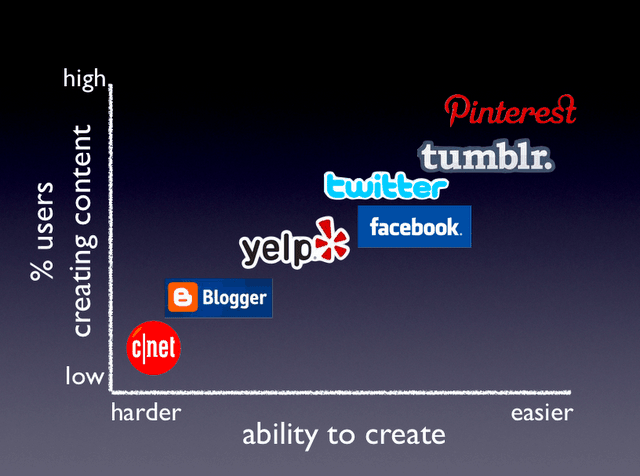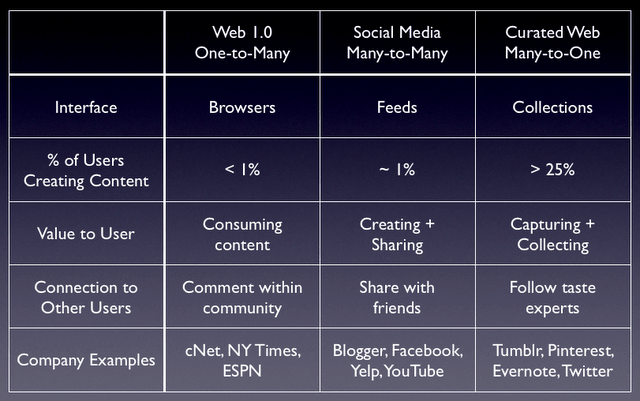Here’s the gist:
- Disruptive web innovation comes from changes in interface.
- Interfaces, which make information easier to understand by mainstream users, create world-changing companies.
- The next stage of the web is the Curated Web, which like the stages before, will create massive opportunities for entrepreneurs who see the trend.
Is this it? Really? Facebook wins, cashes in its chips, and we all go home?
Of course, there is more to come and it’s a future filled with sheer awesomeness. Within the next few years, technology will improve your life in ways you can scarcely imagine. But if you’re looking for where we’re headed, it’s useful to know where we’ve been and most importantly, we should know the catalyst driving us from one phase to the next.
Though tech types tend to focus myopically on the laws of hardware innovation, including those written by Moore, Metcalfe and Kryder, these principles focus on infrastructure, which is only the first phase of a rising technology wave. After infrastructure, technology waves enter a platform and finally an application phase. It is during the platform phases in particular that entrepreneurs build world-changing companies without much initial capital, a la Gates and Zuckerberg. How do companies change user behavior so profoundly and produce massive growth, seemingly overnight?
I believe we can we plot the growth of online media companies against a predictive trend, like Moore’s law does for hardware. The percentage of users creating content is a function of users’ ability. That is to say, the easier it is to create content the more people create it. But why should we care about content creation? Because content creation has exponential benefit to the community and is by definition how online media platforms succeed. Platforms must enable users to create content valuable for other users; the business’ viability depends on it and the economics won’t work any other way.

The trend line of the relationship between the percentage of users creating content and users’ ability, plots the history of the web and helps predict what’s next. It was the graphical user interface, developed by researchers at Xerox PARC and brought to market by Apple and Microsoft, which made hard-to-understand DOS terminals usable and hearkened the PC revolution. The web browser commercialized by Netscape, took advantage of infrastructure used by academics to help create Web 1.0. Next, Facebook took technologies like BBS and RSS to the masses by perfecting the Feed. Smart entrepreneurs, who took a technology mainstream by making it easier to use, spurred each successive phase of the web. The interface drove innovation by making previously incomprehensible information useful, driving an explosion of new user behavior and creating huge companies along the way.
Welcome to the Curated Web

If you want to know what’s next for the web, look at where the interface is changing. Listen for where non-technical people say, “There is too much going on! Who can make sense of it all?” That’s exactly the cry the founders of companies like Pinterest, Evernote and Tumblr are answering. These companies mark the dawn of what I call the Curated Web.
The Curated Web is characterized by a fundamentally different value to users than the social web. Whereas Web 1.0 was characterized by content published from one-to-many and social media was about easily creating and sharing content, from many-to-many, the curated web is about capturing and collecting only the content that matters, from many-to-one. Like all successive phases, the curated web is a response to the weaknesses of the previous phase. Users inundated with too much content are looking for solutions to help them make sense of it all. Curated Web companies solve this problem by turning content curation into content creation and, following the predicted trend line, they see unprecedented percentages of user participation. Each re-pin, re-blog, re-tweet, creates a curated, easy-to-use stream for future information to flow.
By designing new interfaces, and suddenly making information accessible, innovative companies have just begun creating the Curated Web. By extrapolating the trend line, we can expect new startups to engage even higher numbers of users in creating content by making content creation even easier. As our ability to create content increases, perhaps one day becoming nearly effortless, we are likely to see new interfaces to help us make sense of all the data, and hearkening the next phase of the web.
Related Articles
- Schedule Maker: a Google Sheet to Plan Your Week
- Cancel the New York Times? Good Luck Battling “Dark Patterns”
- How to Start a Career in Behavioral Design
- A Free Course on User Behavior
- User Investment: Make Your Users Do the Work
- Variable Rewards: Want To Hook Users? Drive Them Crazy
- The Hooked Model: How to Manufacture Desire in 4 Steps
